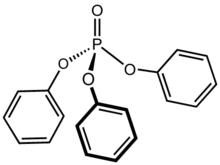Triphenyl phosphate
Agent Name
Triphenyl phosphate
CAS Number
115-86-6
Formula
C18-H15-O4-P
Major Category
Other Classes

Synonyms
Celluflex TPP; Disflamoll TP; Phenyl phosphate ((PhO)3PO); Phosflex TPP; Phosphoric acid, triphenyl ester; TP (VAN); TPP; Trifenylfosfat [Czech]; Triphenoxyphosphine oxide; Triphenyl phosphate; Triphenylphosphate; [ChemIDplus]
Category
Organophosphates, Other
Description
Colorless, crystalline powder with a phenol-like odor; [NIOSH]
Sources/Uses
Used as a plasticizer, fire-retardant, and substitute for camphor in celluloid; also used in lubricating oils and hydraulic fluids; [ACGIH]
Comments
Cholinesterase inhibition, but no cumulative toxicity, was observed in animal studies. A study of 33 workers (employed for an average of 7.4 years) in a plant manufacturing TPP found no adverse health effects. A slight reduction in erythrocyte cholinesterase activity was found in six workers. One case of occupational allergic contact dermatitis has been documented. [ACGIH] In high-dose animal studies, adverse effects include delayed paralysis similar to that seen with tri-o-cresyl phosphate. [HSDB]
Biomedical References
Exposure Assessment
Skin Designation (ACGIH)
Insufficient data
TLV (ACGIH)
3 mg/m3
PEL (OSHA)
3 mg/m3
MAK
10 mg/m3, inhalable fraction
IDLH (NIOSH)
1000 mg/m3
Excerpts from Documentation for IDLHs
Human data: Workers exposed to an average air concentration of 3.5 mg/m3 for as long as ten years showed no evidence of adverse clinical effects [Sutton et al. 1960]. . . . Basis for revised IDLH: The revised IDLH for triphenyl phosphate is 1,000 mg/m3 based on acute oral toxicity data in animals [Antonyuk 1974].
Vapor Pressure
2E-06 mm Hg
Explanatory Notes
Flash point = 220 deg C; VP from HSDB;
NFPA
must be preheated
Adverse Effects
Skin Sensitizer
Yes
Neurotoxin
Predominantly motor
ACGIH Carcinogen
Not Classifiable
Diseases, Processes, and Activities Linked to This Agent
Diseases
Occupational diseases associated with exposure to this agent: